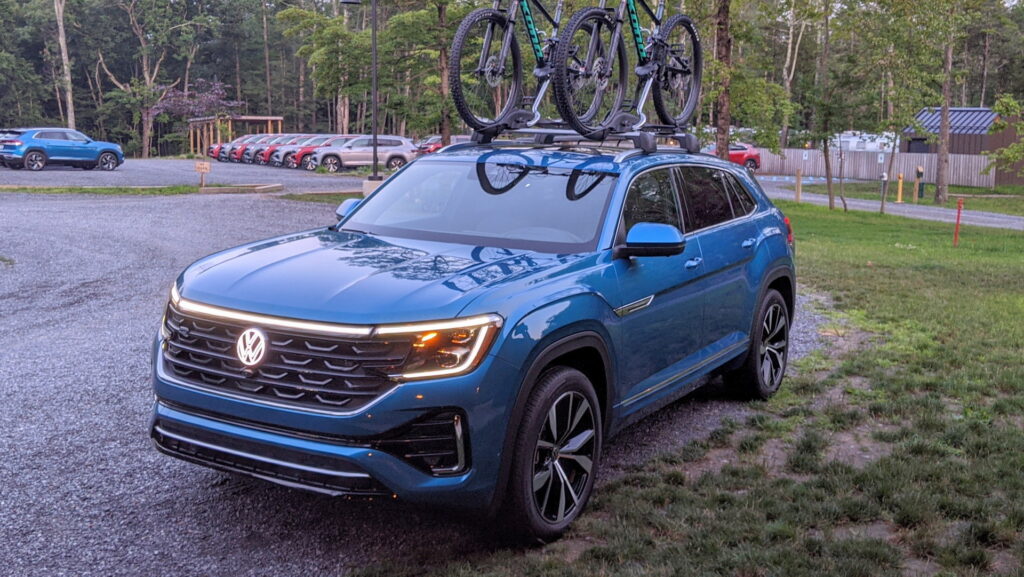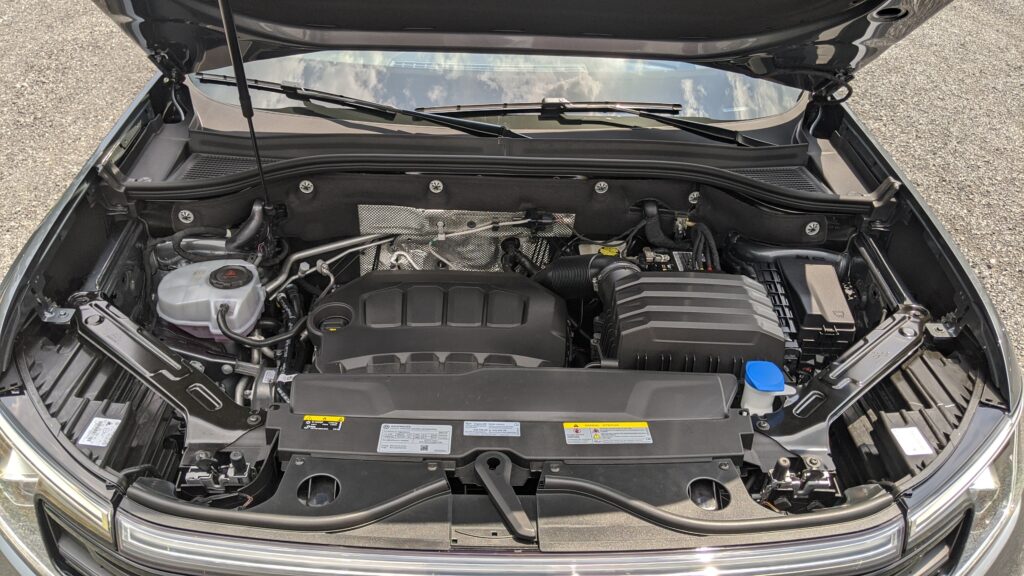This updated pair of SUVs offers a lot more for brand loyalists but still isn’t at the top of its class
July 14, 2023 at 09:00
 –>
–> 
–>
The Volkswagen Atlas debuted in 2018 as an indirect replacement for the Touareg in the US. It showed up as the first VW ever specifically designed for the US market. Today, roughly half a decade later, it’s getting its second major refresh and the slightly smaller Atlas Cross Sport is getting its first.
After spending a couple of days in the Catskills with both the Atlas and the Atlas Cross Sport, we have a better understanding of what they are and what they aren’t, so here’s a full breakdown of what you need to know about them.
LED Lighting Everywhere
For the regular Atlas, this is the second time in about five years that Volkswagen has given it a facelift. Aesthetically, that’s an appropriate term for the exterior too as this is an evolutionary step forward rather than a dramatic shift.
The front fascia gets new LED headlights and a redesigned bumper cover. Most trim levels are available with an illuminated VW badge and an LED light bar at the front of the hood. The rear of the Atlas also gets LED lighting including a heckblende strip connecting each side with a single strip across the tailgate.
Read: What Do You Want To Know About The 2024 VW Atlas And Atlas Cross Sport?
advertisement scroll to continue
The Atlas Cross Sport benefits from the same adjustments so that now both SUVs look almost identical. In fact, without them parked next to one another we bet many non-automotive enthusiasts would struggle to tell them apart. The Atlas Cross Sport has a sharper rear roofline and sits lower to the ground than the Atlas, which is the only one of the two to offer a third seating row. The two cars share a wheelbase and track so the only changes come in the form of that extra space.
Notably, the two models share the same five main trim levels: SE, SE with Technology, SEL, SEL R-Line, and SEL-Premium R-Line. The Atlas benefits from two new trims that it announced last year called the Peak Edition SE with Technology, and the Peak Edition SEL.
The Peak versions add all-terrain tires and then nothing more than aesthetic changes to indicate additional off-road readiness. For a deeper dive into each trim see our explainer here. Pricing starts at $38,065 MSRP for the Atlas Cross Sport and at $39,075 MSRP for the larger Atlas. VW says the Atlas is their most profitable model in America.
Updating The Front Row
All of the biggest changes for the 2024 Atlas and Atlas Cross Sport come under the sheet metal. For instance, there’s a brand new dashboard with a larger and more prominently featured 12-inch infotainment system, more soft-touch surfaces, and less plastic than before. Every Atlas regardless of trim level also comes with a 10.25-inch digital gauge cluster. It’s highly configurable and worked flawlessly for us. A heads-up display is also available as is a 30-color ambient interior lighting feature.
The infotainment system was a bit of a mixed bag though. Gone are the physical buttons and knobs of yesteryear. Now Atlas owners will make do with a touchscreen and capacitive buttons only. In fact, even those capacitive buttons are kept to a stark minimum.
Want to change the fan speed while someone else inputs navigation directions? No. How about changing the radio station while someone else turns on the AC? Also no. Basically, the system allows one main function at a time except in rare circumstances where it will display multiple functions.
The center console also features an all-new design with shift-by-wire technology that provides space for a new storage cubby underneath the upper level of the console. Heated and ventilated front seats are standard across the lineup. Beyond those very specific changes, the rest of the interior is nearly the same as the outgoing model.
The door cards feature very slightly different styling but don’t lose any of the nice storage that was available in the 2023 model. We especially love the three cubby bins on the back doors as there’s a space specifically for a drink, some stuff, and then a phone. It’s worth noting that it’s in the second row that the big differences between the Atlas and the Atlas Cross Sport start to really show up. For starters, the phone holder in the door is bigger in the Atlas but that’s only the beginning of the extra space.
I’m 6 foot 6 and had no issue whatsoever riding around in the second row of the Atlas. The Atlas Cross Sport was another story though. There is half an inch less headroom in the Cross Sport’s second row and I noticed it straight away as my head hit the roof. The seats are reclinable though and that fixed my problem, albeit with no headroom to spare. Legroom is fine in both vehicles, and each one is available with heated second-row seats.
The captain’s chairs in the Atlas still come with excellent armrests and they have two ways of folding so you can sandwich them and kick your feet up from the third row or you can simply have the whole seat kneel and slide forward to provide easy access to the third row. The third row itself has a few nice features like multi-sized cupholders and two USB-C ports. Keep in mind though that both power outlets are on the driver’s side. Kids don’t argue about who has access to those, do they?
Behind the third row in the Atlas, you’ll get just over 20 cubic feet of storage while the Atlas Cross Sport offers double that at 40.3. With the second- and third-row folded, the Atlas takes the lead with up to 96.8 cubic feet while the smaller Cross Sport gets by with just 77.8 cubic feet.
A Single Powertrain To Rule Them All

The other big shift is under the hood in the form of a new generation 2.0-liter turbocharged four-cylinder engine. It makes 269 hp (198 kW) and 273 lb-ft (370 Nm) of torque and now serves as the only powertrain available in either Atlas. That’s 34 more ponies (25 kW) than from the outgoing 2.0-liter and only 7 fewer (5 kW) than in the now-gone VR6 V6.
This new engine sends that power to either the front wheels or all four through an eight-speed automatic gearbox. Despite losing a bit of top-end horsepower over the old V6, this new 2.0-liter engine actually makes a bit more torque which in turn has helped the Atlas maintain its 5,000-pound towing capacity. Though maybe don’t try to tow the Airstreamer Caravel they had hooked up to the one below. Its GVWR is exactly 5,000 pounds so if my understanding is correct, you’d have to travel with exactly nothing in it.
According to the EPA, the Atlas and Atlas Cross Sport get up to 20 mpg in the city and 27 on the highway when properly equipped. That’s 23 mpg combined, which is exactly 1 mpg better than the outgoing 2.0-liter while also offering more power. In our testing, fuel economy figures for each Atlas variant saw combined scores of just under 20 mpg.
Piloting The Pilot Rival
Over the course of our time in the Atlas and Atlas Cross Sport, it felt perfectly adequate. Body roll was noticeable but not egregious. Volkswagen didn’t add any special new suspension bits or tuning so if you’ve driven the old Atlas this will feel similar. The shocks don’t soak up bumps and bruises in the road as nicely as you might find in some rivals. As such, the second and third rows can get a bit bumpy at times.
The steering feedback and pedal input requirements are nicely refined but by no means athletic. The engine does a fine job of getting the Atlas up to everyday traffic speeds but passing on the highway felt like serious labor. There’s simply no getting around the fact that this is a vehicle that weighs well in excess of two tons and that’s just the two-row version. What will it feel like when loaded down with a family of five and all of their stuff? What would the three-row Atlas feel like with seven people and their gear?
On the positive side, the cabin is reasonably quiet save for a loud climate control system and the visibility out of the front and through the wing mirrors is great. The transmission is smooth and the driver aids offer above-average assistance. The lane-keeping system can lose its way very easily but the adaptive cruise and forward collision warning both operate at a high level that feels natural and intuitive.
Does It Compete?
On paper, the Atlas looks very similar to the Honda Pilot. It makes slightly less horsepower but more torque. The Peak Edition doesn’t match the off-road changes to the Pilot TrailSport but the Atlas does feel nicer inside. And finally, it offers a bit more limited warranty coverage but a bit less powertrain coverage. That last point is key too because there’s no way to know just how reliable this new powertrain or the rest of the car will be.
For example, the 2021 Honda Pilot currently has been subject to six recalls and 106 complaints with the NHTSA. The 2021 VW Atlas has 185 complaints and a whopping 16 recalls already. That’s by no means a perfect or scientific measure but it’s indicative of a real long-term factor for those cross-shopping these vehicles.
Take a broader look around the segment and other rivals seem to offer other facets that the Atlas is missing as well. The Mazda CX-9 drives better and is as nice if not nicer on the inside. We have little doubt that the all-new CX-90 will raise that bar even higher. The Jeep Grand Cherokee and Grand Cherokee L both offer more available power and serious off-road capability. Finally, the Kia Telluride and Hyundai Palisade both off similarly nice non-minivan minivan experiences with far more warranty coverage.
It’s Fine
As a sum of its parts, the updated Atlas and Atlas Cross Sport seem like two SUVs that simply aim to be good, not excellent. That’s not a knock to the team that made these updates either. But, since this is VW’s most profitable vehicle in the USA, someone could argue that VW could use some of that juicy profit towards crafting a more enticing offering with more performance, better materials, or more off-road capability.
Don’t get us wrong about the Atlas. This is a decent SUV. It drives perfectly fine. It looks totally okay. The interior is a real step forward, and the exterior lighting updates are good too. At the same time, we can’t picture this thing really snagging too many sales from brands like Kia, Hyundai, Jeep, and Mazda as each of them offer more value for money. At the same time, VW fans will love these updates and likely be willing to lose a bit of that value per dollar to remain loyal to the brand. It’s a Volkswagen thing… those of us who don’t get it don’t have to understand.

